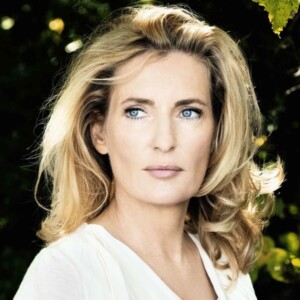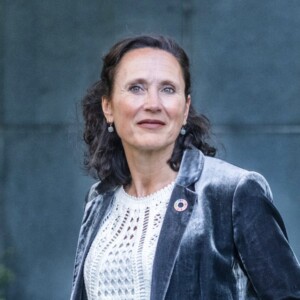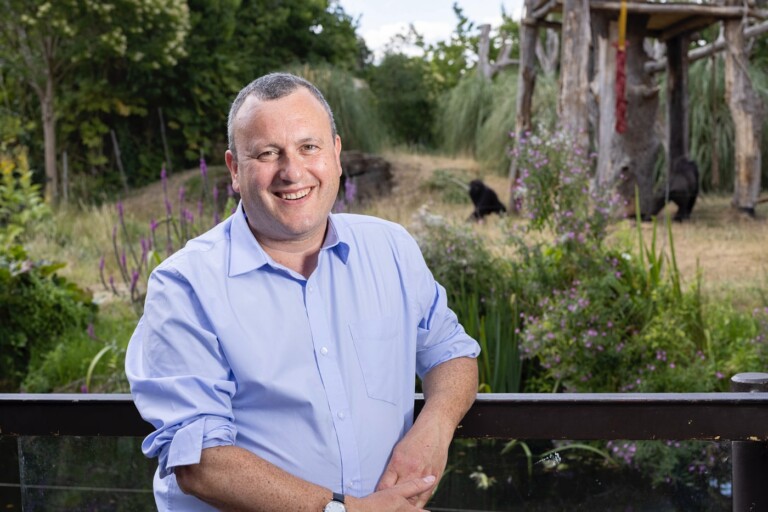
Quick Takes from DLD Nature
When technology meets biodiversity a world of opportunities opens up. These insights from our recent conference show why it pays off to invest in healing the planet.
How much would a glass of honey cost if bees were paid minimum wage? The answer – 300,000 euros – may surprise you. Which goes to show how much we’re taking nature’s services for granted. Until it’s too late. In some parts of China, the decline of wild bees now forces farmers to climb into trees and pollinate blossoms by hand.
“We need a fundamental rethink of the relationship between our economy and the natural world”, Ursula von der Leyen, President of the EU Commission, demanded in her DLD Nature keynote.

Ursula von der Leyen
EU Commission President
“For generations, humanity has only rewarded the plundering of our natural environment. Today we see how fundamentally wrong this is.”
Ms. von der Leyen’s speech was one of many highlights of the recent DLD Nature conference. You can watch videos of all sessions in our Youtube playlist and find images of day 1 and day 2 on our Flickr albums. Below, you’ll find key insights and memorable quotes of select sessions.
1. Biodiversity Loss and Climate Change Go Together
“We are risking the stability, the resilience, and the very life support of the entire planet”, Johan Rockström, Director of the Potsdam Institute for Climate Impact Research, warned in his DLD Nature presentation. As the planet keeps heating up it becomes more important than ever to “maintain biodiversity to keep the buffering capacity in the climate system intact”, Rockström explained.
The best-known example is the Amazon. A healthy rainforest sucks CO2 out of the atmosphere as its trees and plants convert the greenhouse gas through photosynthesis, making the Amazon one of the world’s largest carbon sinks.
But deforestation has brought the rainforest dangerously close to a tipping point where it would lose its ability to absorb CO2, Rockström warned. “We’ve come to the end of the road of losing nature”, he said. “Just biodiversity loss can take us over 2 degrees Celsius” of global warming. “So nature is a fundamental prerequisite to deliver on the Paris Agreement.”
The Double Crisis: Climate & Biodiversity. Watch Johan Rockström’s DLD Nature talk.
2. Nature Is Undervalued
“Waking up to the song of birds, drinking water from a mountain spring, staring at the endless blue of the sea and the ocean – how could you possibly put a price tag on any of this?”, Ursula von der Leyen asked in her DLD Nature keynote. “Well, we do put a price tag on nature every second, every day”, she noted. “But only by taking resources away from their natural environment.”
The President of the European Commission called for incentives that reward those who “go the extra mile” to protect the planet. Nature credits, similar to carbon credits, could “create a market for restoring our planet”, she suggested.
DLD Nature Keynote by Ursula von der Leyen.
Currently, markets fail to capture the value of nature’s capital because prices do not reflect whether goods or services harm the environment or help protect it. Such aspects, called “externalities” by economists, typically do not show up in corporate balance sheets.
“Today the markets cannot be efficient because they only have the financial information”, Günther Thallinger, CEO of the insurance group Allianz, noted. “The nature information is completely missing.”
This data gap must be closed, Thallinger demanded, given the massive economic costs to society caused by climate change, pollution, the destruction of ecosystems and other harmful practices.
The Allianz CEO praised the EU’s Corporate Sustainability Reporting Directive as “very good regulation”, defending it against critics who find the new requirements cumbersome and bureaucratic. “If forever we have disregarded nature and we now need to integrate it, is anybody [surprised] that this is an effort?”, Thallinger asked.
Nature: Does Finance Care? Watch the DLD talk by Allianz CEO Günther Thallinger.
3. Act Now!
The world has a goal: By 2030, at least 30% of Earth’s land and sea are supposed to be protected for conservation. This “30×30” target of the Global Biodiversity Framework was adopted by 196 countries at the latest UN Biodiversity Conference (COP15) in 2022.
But will it be enough? Many speakers at DLD Nature see a need to move faster and go further. “The decisive decade is the twenties”, Günther Thallinger emphasized. “We do all of these wonderful programs, and then we are ready to protect nature – but there is no nature to protect” anymore, he worried.
Author and transformation scholar Maja Göpel demanded more urgency as well. “Not doing anything right now is the most costly thing” humankind can do, she argued. Much of the inaction, she believes, is due to the fact that “nature can’t claim political space for itself. It needs advocates because it’s silent, often invisible.”
Understanding System Traps for Transformative Policy Making: Watch Maja Göpel’s DLD Nature talk.
4. Technology is Here to Help
Preservation needs information, because to protect nature, scientists must first understand how complex ecosystems work. Luckily, a range of technologies offer new ways to observe animals and their habitats, collect environmental data and analyze it far more quickly, cheaply and comprehensively than ever before.
Cameras and sensors are able to monitor what goes on in parks or forests without disturbing animals, never missing a beat. “We can look at species, we can look at poachers, and we can identify behavior“, Alex Dehgan said, whose company, Conservation X Labs, uses AI to speed up analyzing the data that its devices collect.
Artificial intelligence can also help to decode the language of animals, as the Earth Species Project shows, and make sense of environmental DNA, the genetic material that is left behind by organisms in their environment.
Tech Solutions for Preserving Biodiversity: Deep Dive session with Kat Bruce, Alex Dehgan, Mirko Kovac and Michael Schmidt, moderated by Frauke Fischer.
Nature Metrics aims to use insights from eDNA analysis “to engage and inspire decision makers”, Founder Director Kat Bruce said, but also “to feed into corporate reporting”.
This is crucial for incentivizing investors and companies, many experts believe. “We need the reliable data and metrics that can underpin an economic framework in which we properly value nature”, Matthew Gould, Director General of the Zoological Society of London (ZSL), argued.
His organization compiles the Living Planet Index, which is considered an important indicator to measure progress on biodiversity preservation.
Advanced technologies give ZSL researchers a chance to “change the way we gather data and then begin to build models to understand why that has happened and make predictions about what’s going to happen in the future”, said Robin Freeman, who’s in charge of the project.
Breaking the Species Divide: Watch the conversation between Matthew Gould, Robin Freeman and Jonathan Ledgard, moderated by Eleanor O’Keefe.
Robots are likely to become an important part of this task. One example are drones that can shoot darts into trees, so that sensors – which are embedded in the darts – can collect data for environmental monitoring.
“Robotics is a very good tool for biodiversity measurements”, said Mirko Kovac, who deloped the drone concept with colleagues the Imperial College London and also heads the Laboratory of Sustainability Robotics at EMPA in Zurich. “Robots can go where it’s relevant to collect the data”, he added. “We can think of them as a Swiss army knife of environmental sensing that has all possible capabilities to do good, helpful things for environmental scientists, for the whole sustainability community.”
To complete the picture, researchers can access more and more satellite images of endangered ecosystems – an important addition to their toolbox. “There has been a revolution over the last years in big data science, machine learning, AI, satellites, ground truthing”, noted Alexa Firmenich, founder of Naia Trust. “For the first time ever we’re pulling together a quantative view of the Earth’s ecosystems that’s allowing us to see dynamics on the ground that we have never perceived before.”
Sensing Nature: Watch the DLD Nature talk by Alexa Firmenich.
5. Security Issues
It’s easy to overlook many not-so-obvious effects of nature degradation. Former NATO general Tom Middendorp didn’t have climate change on the forefront of his mind, he admitted, until he witnessed social tensions in Afghanistan that were “all about water scarcity”. Many similar observations in other parts of the world led him to the conclusion that “climate change and biodiversity are also a matter of national security”.
Middendorp’s reasoning is simple: As the global population keeps growing, there is “increasing demand for space, for water, for food, for resources”, he explained. But the planet cannot keep pace with all these increasing human needs – “so there is a growing global gap between demand and supply. And if history teaches us one thing, it’s that shortages give frictions, and frictions give conflicts.”
Such insights prompted Middendorp to write a book, The Climate General. At DLD Nature, he urged business leaders and politicians to act quickly, before it’s too late. “It’s very important to see it coming, to not react and respond to the effects of a changing climate, but to get ahead of the game.”
Security researcher Florian Krampe, who heads the Climate Change and Risk program at SIPRI, fully agrees. “We can’t make the same mistake with biodiversity that we made with climate change”, he said. “We have been debating causality for 20 years, instead of recognizing 20 years ago that the risk is very clear and that we need to act. If we wait for facts and prove that climate change or biodiversity loss causes conflict and causes insecurity, we will be too late.”
Biodiversity Loss: A Security Issue!? Get insights from Benedikt Franke, Florian Krampe and Tom Middendorp.
6. Regeneration
Nature has an incredible power to heal itself, even after significant damage – provided we give it a chance. Once a species is extinct, it’s gone. But in many other ways, animal populations and ecosystems are able to recover remarkably quickly. “It takes just one human generation to regenerate a rainforest, arguably the most complex ecosystem on Earth”, Martin Schaefer, CEO of Fundación Jocotoco in Ecuador, pointed out.
Overall, three “relatively simple measures“ would be enough to increase biodiversity again, Katrin Böhning-Gaese, director of the Senckenberg Biodiversity and Climate Research Centre, suggested: creating protected areas with restoration efforts; shifting to “sustainable but productive agriculture”; and consuming less meat – to make land usage more effective and decrease methane emissions.
“The interesting thing about biodiversity is that there seem to be no tipping points”, Katrin Böhning-Gaese observed. “It’s a linear relationship, which means that you can also increase biodiversity again.”
Impact through Wonder: Watch the DLD Nature session with Katrin Böhning-Gaese, Lena Thiele, Tom Kortbeek, Sabine Hansky and Sarah Dorkenwald.
7. The Smartest Investment
“We have depleted natural capital all the way to the breaking point”, Martin Stuchtey noted. “The bank is empty.” His company, The Landbanking Group, aims to refill it by making nature a “new kind of asset class” for investors.
The need for such projects is clear, as many sessions showed – and it goes far beyond philanthropy.
“Nature is our most important supplier”, Tobias Raffel of the Senckenberg Society for Nature Research pointed out. Besides food, many medicines are derived from natural ingredients, the fashion industry relies on cotton, silk and other fabrics. Altogether, ecosystem services are “worth more than $150 trillion annually”, about twice the world’s GDP, according to consultancy BCG.

Maria Furtwängler
MaLisa Foundation
“Healthy nature is the basic prerequisite for a healthy economy.”
If the benefits of protecting nature are so obvious, why do we risk further harm? Blame our tendency to enjoy short-term benefits and ignore the long-term consequences, Stefan Wintels, head of KfW banking group, suggested. “We close the eyes, we dance as long as the music plays”, he said. “We need to solve the conundrum that short term there is no incentive whatsoever to change your behavior.”
Building a Business Case to Save the Planet: Watch the conversation between Johan Rockström, Stefan Wintels, Martin Stuchtey and Solveigh Hieronimus.
A mix of new regulations, business incentives and technologies documenting the positive impact of nature preservation could do the trick, many experts hope. “There’s a reason why the finance sector avoided the biodiversity space, because there was no story to tell within an Excel sheet”, Korbinian Kantenwein, founder of Nature Wealth, observed. “Now we have live data to measure biodiversity” which can form the basis “to build a product or even an asset class“, he said. “This really can be a game changer to activate the private sector.”
And finally, perhaps most importantly, the message must change as well – become more emotional, with an emphasis on positive images. “Let’s move from risk to opportunities and think about what we can do, how can we be part of the solution”, Tobias Raffel said.

Sandrine Dixson-Declève
Club of Rome
“We are nature, and nature is us. Full stop.”
Choice of words matters, too, Stefan Wintels noted. “Everybody loves nature. There’s not a single human being who doesn’t love nature.” In contrast, the term “biodiversity” sounds too technical, he believes. “It makes people switch off.”
“My appeal would be: Dare to be emotional, dare to come from the heart, because that’s been missing from science communication for a very, very long time”, Eckart von Hirschhausen, a medical doctor and well-known TV personality in Germany, told the audience.
The word “environment” was misleading, he continued, ”because it suggests that everything else simply surrounds us. But we’re not the center of the world. We’re interconnected with the world.”
In his closing keynote, Eckart von Hirschhausen traveled to the future, imagining what today’s children will ask when they’re confronted with the consequences of the decisions we make today.
“These children will ask us all: ‘What did you know in 2024, what was in your power and what did you do? What was our future worth to you?’ And I hope that we all have really good answers when this question comes.”
Closing Keynote: Watch Eckart von Hirschhausen’s farewell remarks (German with English subtitles).

